Occasionally indulging in a surf ‘n’ turf dinner is a delightful treat. Let’s admit it, the temptation to share a succulent piece of lobster with our feline friends can be hard to resist. So, can cats eat lobster?
Yes, cats can eat lobster. Considering cats’ affinity for seafood, assuming they would also enjoy lobster is natural.
However, before offering lobster to your cat, it is crucial to ensure their safety. While cats can consume lobster, certain conditions will keep them safe and healthy.
Firstly, you should cook the lobster safely without any seasonings or additives. Secondly, feeding lobster to cats in small quantities is essential.
Excessive consumption could lead to an imbalanced diet and potential health issues.
Read on to learn more.
Before you scroll further down this guide, check out these other cat-related articles: Does a Cat Poop on the Floor When Angry? and Why are My Cat’s Whiskers Curly?.
Table of Contents
Are Lobsters Safe For Cats?
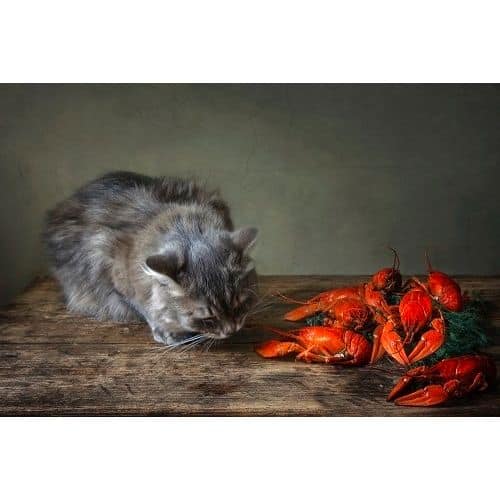
In moderation, cats can safely enjoy lobster as part of their diet. Cats are fond of seafood flavors like shrimp, salmon, and tuna.
However, it’s understandable to have concerns about the suitability of lobster for feline consumption.
Incorporating lobster into your pet’s diet can provide an excellent protein source and introduce a touch of seafood variety.
Nevertheless, it’s important to note that relying solely on seafood, including lobster, will not adequately sustain your cat or provide all the necessary nutrients for its well-being.
Consider treating lobster as an occasional indulgence rather than a daily food source.
While lobster is generally safe for cats, some cats may have a seafood allergy.
It’s crucial to be mindful of this possibility and consult your local veterinarian to determine if your furry companion has any allergies before introducing any type of seafood, including lobster, into their diet.
What About Raw Lobster?
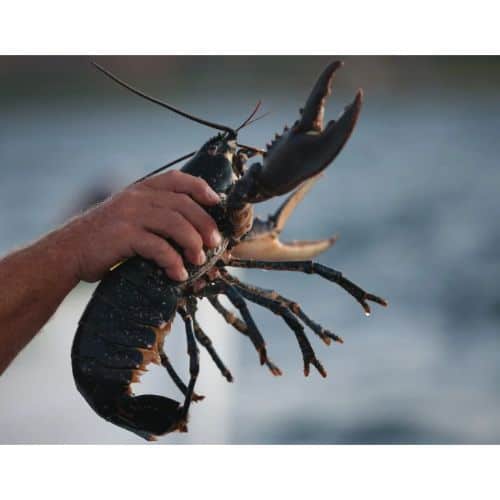
Feeding your cat raw lobster is strongly discouraged. It is crucial to cook lobsters thoroughly to prevent the transmission of harmful bacteria and parasites to your pets.
You might wonder why you can consume raw sushi while your cat cannot have raw seafood.
While some of our feline companions possess the instinct to hunt, kill, and eat raw fish, this behavior is not prevalent among domestic cats.
Domestic cats have descended from desert-dwelling ancestors with minimal exposure to fish.
Raw seafood presents significant health risks.
Crayfish, crabs, and lobsters can harbor a parasite called Paragonimus, specifically lung fluke, which can be transmitted to cats.
Ingesting lobster contaminated with bacteria such as Salmonella or Vibrio can cause severe stomach pain and digestive issues for cats due to the bacteria present in the shellfish.
Cooking lobster thoroughly before offering it to your beloved cat is crucial to safeguard your cat’s well-being.
Is Lobster Shell Safe For Your Cat?
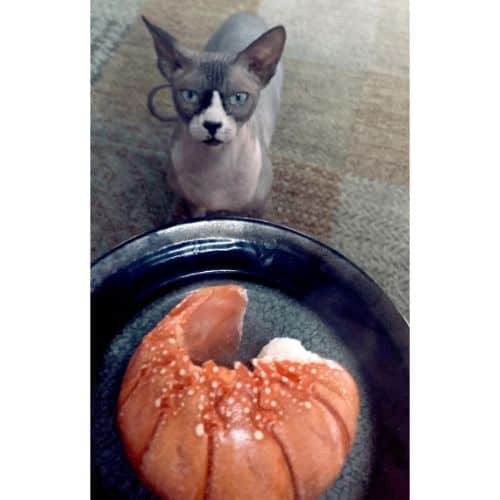
While the meat of lobster is generally safe for cats, it’s important to note that the shells are not.
Lobster shells can possess sharp edges that pose a potential danger. Despite your cat’s sharp teeth, they won’t be able to chew the shell adequately before swallowing.
The short fragments can easily puncture your cat’s gums, mouth, throat, or esophagus, causing choking and pain while attempting to remove the pieces from their mouth.
Occasionally, you can give lobster within the shell for presentation purposes, but this practice is primarily for aesthetic appeal.
The safest approach when feeding lobster to your cat is to offer them small, shell-free pieces of meat in their bowl.
Before serving, wash your hands and carefully inspect the flesh to remove small, sharp shell fragments.
If your cat accidentally consumes some shell, it is unnecessary to be concerned about it being toxic.
However, monitoring your cat closely for any signs of discomfort during digestion over the next few days is advisable.
Safest Way To Feed Lobster To Your Cat
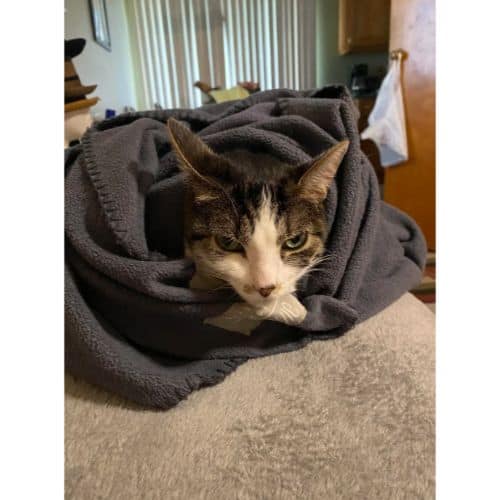
As previously mentioned, when feeding lobster to your cat, it is of utmost importance to ensure proper cooking.
Additionally, being mindful of the spices and butter used is vital, as they can potentially lead to health problems.
If you are determined to offer lobster to your cat, refrain from cooking it with any additional ingredients.
The lobster meat should be plain and thoroughly cooked.
Even salt and pepper is not advisable, as it may trigger diarrhea, vomiting, and stomach discomfort, which you should avoid for your cat’s well-being.
Health Benefits Of Lobsters
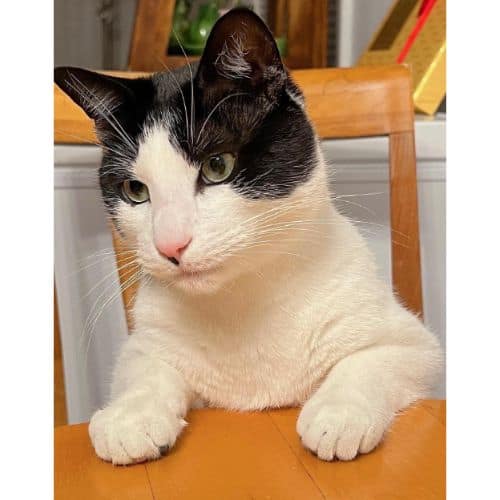
Lobster offers several advantages for cats, including its abundance of amino acids.
These amino acids play a vital role in protein synthesis within the body.
Not only does lobster tantalize the taste buds of cats, but it also contributes to the development of essential proteins. Also, lobster meat is low in carbohydrates, which can benefit cats.
Furthermore, lobster meat is rich in various vitamins that significantly benefit cats. These vitamins include phosphorus, zinc, vitamin B12, and vitamin E.
Each vitamin is crucial in supporting cats’ overall health and well-being. Cats can access these essential vitamins that contribute to their nutritional needs by including lobster.
FAQs About Cats Eating Seafood
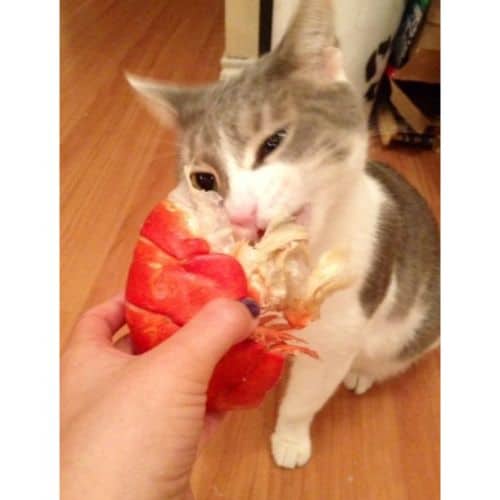
Is it okay for cats to eat lobster?
Cats are obligate carnivores, which means their natural diet consists mainly of meat.
While cats can consume a variety of meats, including fish, it’s important to note that certain types of seafood, such as lobster, may not be suitable for cats.
Lobster is high in protein, which is beneficial for cats, but it also contains high levels of sodium and potentially harmful compounds, such as heavy metals or toxins.
Additionally, lobster shells can present a choking hazard or cause digestive issues if ingested by cats.
Suppose you’re considering feeding your cat seafood.
Sticking to cat-friendly options like cooked fish (without seasoning or bones) or commercially prepared cat food specifically formulated to meet their nutritional needs is generally best.
It’s always a good idea to consult a veterinarian before introducing new foods into your cat’s diet to ensure their health and safety.
Can cats eat shrimp and lobster?
Cats can occasionally eat small amounts of cooked shrimp or lobster, but taking certain precautions is essential. Here are a few things to keep in mind:
Remove the shells
Shrimp and lobster shells can be complex for cats to digest and may pose a choking hazard.
Always ensure that the shrimp or lobster meat is fully cooked and free from shells before offering it to your cat.
Avoid seasonings and additives
Plain, unseasoned cooked shrimp or lobster is the best option for cats. Please avoid using herbs, spices, or sauces, as they can harm cats.
Moderation is vital
Shrimp and lobster should be an occasional treat rather than standard cat diet components.
While they can provide some nutritional benefits, it’s important to prioritize a balanced and complete diet specifically formulated for cats.
Watch for allergies or digestive issues
Some cats may have allergies or sensitivities to seafood.
Introduce shrimp or lobster gradually and monitor your cat for signs of adverse reactions such as vomiting, diarrhea, or excessive itching.
If any issues arise, discontinue feeding shrimp or lobster and consult your veterinarian.
Remember, a cat’s primary diet should consist of nutritionally balanced food that meets all its dietary requirements.
Treats like shrimp or lobster should only be in small quantities and as an occasional indulgence.
Consulting with a veterinarian is always recommended before introducing new foods into your cat’s diet.
What seafood can cats eat?
Cats can eat certain types of seafood in moderation. Here are a few seafood options that are generally considered safe for cats:
Cooked fish
Fish such as salmon, tuna, or whitefish can be a good source of protein and omega-3 fatty acids for cats.
It’s essential to ensure the fish is fully cooked and contains no seasoning or bones that could pose a choking hazard.
Canned fish
Canned fish, such as canned tuna or salmon, can be fed to cats as an occasional treat.
However, choosing fish packed in water rather than oil or brine is essential, and opt for low-sodium options.
Small freshwater fish
Small fish like sardines or anchovies can be fed to cats as long as they are fully cooked and boneless.
These fish are nutrient-rich and can be a healthy addition to a cat’s diet.
When offering seafood to your cat, it’s crucial to ensure that it’s cooked thoroughly and doesn’t contain any seasonings, additives, or harmful substances.
Additionally, seafood should only be an occasional treat, not a staple.
Always consult your veterinarian before introducing new foods into your cat’s diet to ensure they suit your cat’s needs and avoid potential health issues.
What seafood can cats not eat?
Several types of seafood are generally considered unsafe or potentially harmful for cats to consume. Here are some examples:
Raw fish
Raw fish, including sushi-grade fish, can contain parasites or harmful bacteria, such as salmonella, that can cause digestive issues or cat infections.
It’s important to always cook fish thoroughly before feeding it to your cat.
Shellfish
Shellfish like clams, mussels, oysters, and scallops are not best for cats. They may contain toxins or be problematic for cats to digest.
Large predatory fish
Larger predatory fish, such as swordfish, sharks, or king mackerel, tend to accumulate higher levels of mercury in their bodies.
Consuming such fish can harm cats due to the potential mercury toxicity.
Raw shrimp or lobster
Raw shrimp or lobster may contain harmful bacteria or parasites that can cause cat digestive issues.
It’s crucial to ensure that shrimp and lobster are not raw before offering them to your cat.
Fish with bones
Fish with small, sharp bones, such as pike or bony fish like herring, should be avoided as they can pose a choking hazard or cause injuries to the cat’s digestive tract.
Always remember that a cat’s primary diet should consist of nutritionally balanced food that meets all its dietary requirements.
Treats like seafood should only be in moderation and occasionally added to their diet.
It’s best to consult a veterinarian before introducing new foods into your cat’s diet to ensure their health and safety.
Can cats eat shrimp?
Yes, cats can eat shrimp in moderation. Shrimp can be a good source of protein and specific nutrients for cats. However, there are a few important considerations:
Cooked shrimp
Cats should only consume cooked shrimp. Raw shrimp can contain harmful bacteria or parasites that may cause digestive issues or infections.
Ensure the shrimp is fully cooked and has no seasoning, additives, or sauces that may harm cats.
Shells and tails
It’s essential to remove the shells and tails of shrimp before feeding them to your cat.
Shrimp shells can be complex for cats to digest and may pose a choking hazard or cause gastrointestinal issues.
Moderation
You should give shrimp to cats as an occasional treat rather than a regular part of their diet.
It’s important to prioritize a balanced and complete cat food that meets all their nutritional requirements.
Allergies and sensitivities
Some cats may have allergies or sensitivities to seafood, including shrimp.
If introducing shrimp to your cat’s diet for the first time, monitor them for any signs of adverse reactions such as vomiting, diarrhea, or excessive itching.
If any issues arise, discontinue feeding shrimp and consult your veterinarian.
Always consult your veterinarian before introducing new foods, including shrimp, into your cat’s diet.
They can guide your cat’s needs and ensure that the food choices are appropriate and safe.
So, Can Cats Eat Lobster?
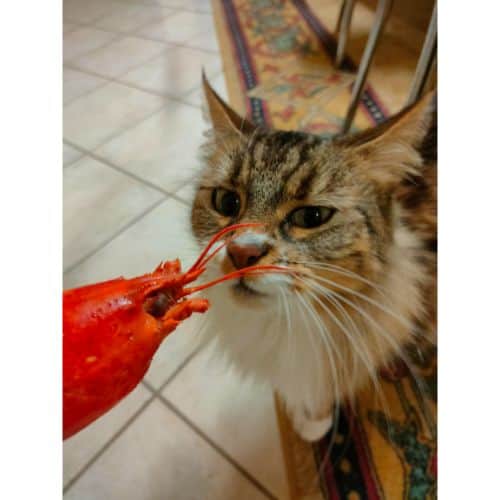
While cats can consume shrimp and lobster in moderation, there are specific considerations to consider.
Cooked shrimp without shells and tails can be offered as an occasional treat, ensuring it is free from seasoning or additives.
However, it’s essential to prioritize balanced cat food as the central part of their diet and treat seafood as an occasional indulgence.
It’s crucial to watch for allergies or sensitivities and consult a veterinarian before introducing new foods.
Additionally, raw seafood, including lobster, should be avoided due to potential bacterial or parasitic risks.
The shells of lobsters are unsafe for cats to consume, and you should remove them.
Overall, the key is to prioritize the safety and well-being of your cat when considering seafood as part of their diet.
If you find this guide, “Can Cats Eat Lobster,” informative and helpful, you can check out these other cat-related articles from our team:
- Is Cooked Chicken Safe for Cats with Kidney Disease?
- Can a Cat Kill a Snake?
- Where Can I Declaw My Cat for Free?
You can learn more about cats diet by watching “Cat Food 101: What, When, & How Much to Feed Your Cat” down below:




